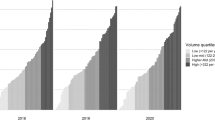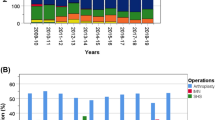Abstract.
Methods: Between 1993 and 1998 data of 27,000 patients with hip fractures and 89,000 patients undergoing cholecystectomy were collected by the department of external quality assurance at the chamber of physicians of Westphalia-Lippe. The data were analyzed for the relationship between volume and outcome, specified as mortality and morbidity. Logistic regression was used to adjust the results for demographic and clinical risk factors. Results: The risk-adjusted probability of death from cholecystectomy was 89 % higher in the group of small volume clinics (less than 30 procedures per year) than in the group of large volume clinics (more than 120 procedures per year) (odds ratio 1.89; 95 % CI 1.19–3.00). Mortality from hip fractures was 33 % higher (odds ratio 1.33, 95 % CI 1.09–1.63) for the group of small volume clinics (less than 15 procedures per year) than the group of large volume clinics (more than 45 procedures per year). Among the group of small volume hospitals were some with excellent results, but they are more likely to be found in the group of large volume hospitals. On the other hand there were some departments with poorer results in the group of large hospitals. Conclusions: There is no threshold for good results. In general there is an inverse relationship between volume and outcome. High volume, though, is not a substitute for good results. It is not possible to infer good quality from high volume alone. Small-volume departments should document quality of care and results thoroughly.
Zusammenfassung.
Methodik: In den Jahren 1993–1998 wurden bei der externen Qualitätssicherung Chirurgie der Ärztekammer Westfalen-Lippe 27.000 Datensätze zur Schenkelhalsfraktur und 89.000 Datensätze zur Cholecystitis/-lithiasis erfaßt. Dieses Datenmaterial wurde auf den Zusammenhang zwischen Fallzahl je Klinik und der Ergebnisqualität für die Parameter Letalität und Komplikationen hin analysiert. Mit multipler logistischer Regression wurde für demographische und klinische Risikofaktoren adjustiert. Ergebnisse: Die risikoadjustierte Wahrscheinlichkeit, im Zusammenhang mit einer Cholecystektomie zu versterben, war in der Gruppe der kleinsten Kliniken (unter 30 Operationen pro Jahr) 89 % höher (odds ratio 1,89; 95 %-Konfidenzintervall 1,19–3,00) als in der Gruppe der Kliniken mit der größten Fallzahl (mehr als 120 Eingriffe im Jahr). Beim Schenkelhalsbruch lag die Letalität in der Gruppe der kleinsten Kliniken (weniger als 15 Operationen pro Jahr) 33 % höher (odds ratio 1,33, 95 %-Konfidenzintervall 1,09–1,63) als in der Gruppe mit den meisten Operationen (mehr als 45 Operationen pro Jahr). Auch in der Gruppe mit der jeweils kleinsten Fallzahl fanden sich Kliniken mit ausgezeichneten Behandlungsergebnissen – wenn auch seltener – wie auch umgekehrt ungünstige Ergebnisse bei großen Kliniken. Schlußfolgerungen: Ein „Schwellenwert“ oder eine Mindestanzahl von Operationen für gute Ergebnisqualität kann aus den Daten nicht abgeleitet werden. Es läßt sich eine inverse Korrelation zwischen Fallzahl und Letalität/Komplikationen feststellen. Hohe Fallzahlen sind jedoch kein Surrogatkriterium für gute Behandlungsergebnisse. Ein Rückschluß aus der Fallzahl einer einzelnen Klinik auf die Behandlungsqualität ist nicht möglich. Kliniken mit geringen Fallzahlen sollten darauf bedacht sein, ihre Prozeß- und Ergebnisqualität besonders sorgfältig zu dokumentieren.
Similar content being viewed by others
Author information
Authors and Affiliations
Rights and permissions
About this article
Cite this article
Wenning, M., Hupe, K., Scheuer, I. et al. Ist viel gleich gut? – Eine Analyse von 116.000 Patienten zum Zusammenhang zwischen Fallzahl und Ergebnisqualität. Chirurg 71, 717–722 (2000). https://doi.org/10.1007/s001040051126
Issue Date:
DOI: https://doi.org/10.1007/s001040051126




